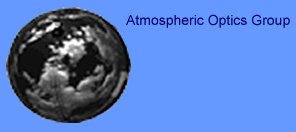
 |
| |
|
|
|
|
|
|
|
Calibration of Sensors - OverviewPurposeOne of the strengths of the Whole Sky Imagers is that they are normally calibrated to provide absolute radiance distributions. Depending on the resolution of the camera, this typically provides at least 100,000 simultaneous measurements of absolute radiance in the selected spectral filter passband. The radiance distribution values in a given passband are acquired at 1/3 to 1/6 degree resolution across the full upper hemisphere of the sky dome. For more details, see the Details Section.
Radiometric Calibration Overview:In order to have accurate calibrations, the instrument must have fixed gain, low stray light, low noise, and a variety of other characteristics as described in the detailed link on required instrument characteristics. As described in more detail in the Calibration Theory, quite a few calibrations are performed as part of the determination of the absolute radiance calibration. These typically include system linearity, shutter calibration, absolute radiance, rolloff, and flat field. Angular Calibrations Overview:The spatial relationship between zenith angle in object
space and pixel position in image space is measured in this calibration.
Whereas this relationship is nearly linear for many fisheyed lenses, it
is MPL's practice to characterize the relationship, and correct for the
non-linearity. The first calibration is based on acquiring images of a
room with markers at specific angular positions, which are accurate to
approximately 0.1 degree. This typically yields results accurate to about
one degree. For a higher precision result, images of star fields are used
and best-fit using a technique originally developed by Dr. Tim Tooman
of Sandia National Labs. Using this technique, we normally obtain angular
precisions of .25 degree or better. For more details, see the Angular
Calibration section. angular precisions of .25 degree or better.Field Calibration Device OverviewA field calibration device has been developed for use with the WSI units used by the ARM program. This device will enable determining linearity, absolute calibration, uniformity, and other calibrations. It includes an automated program to step the user through the data acquisition, as well as an automated IDL program for processing the resulting data.
Produced
by the Marine Physical Laboratory, SIO.
|